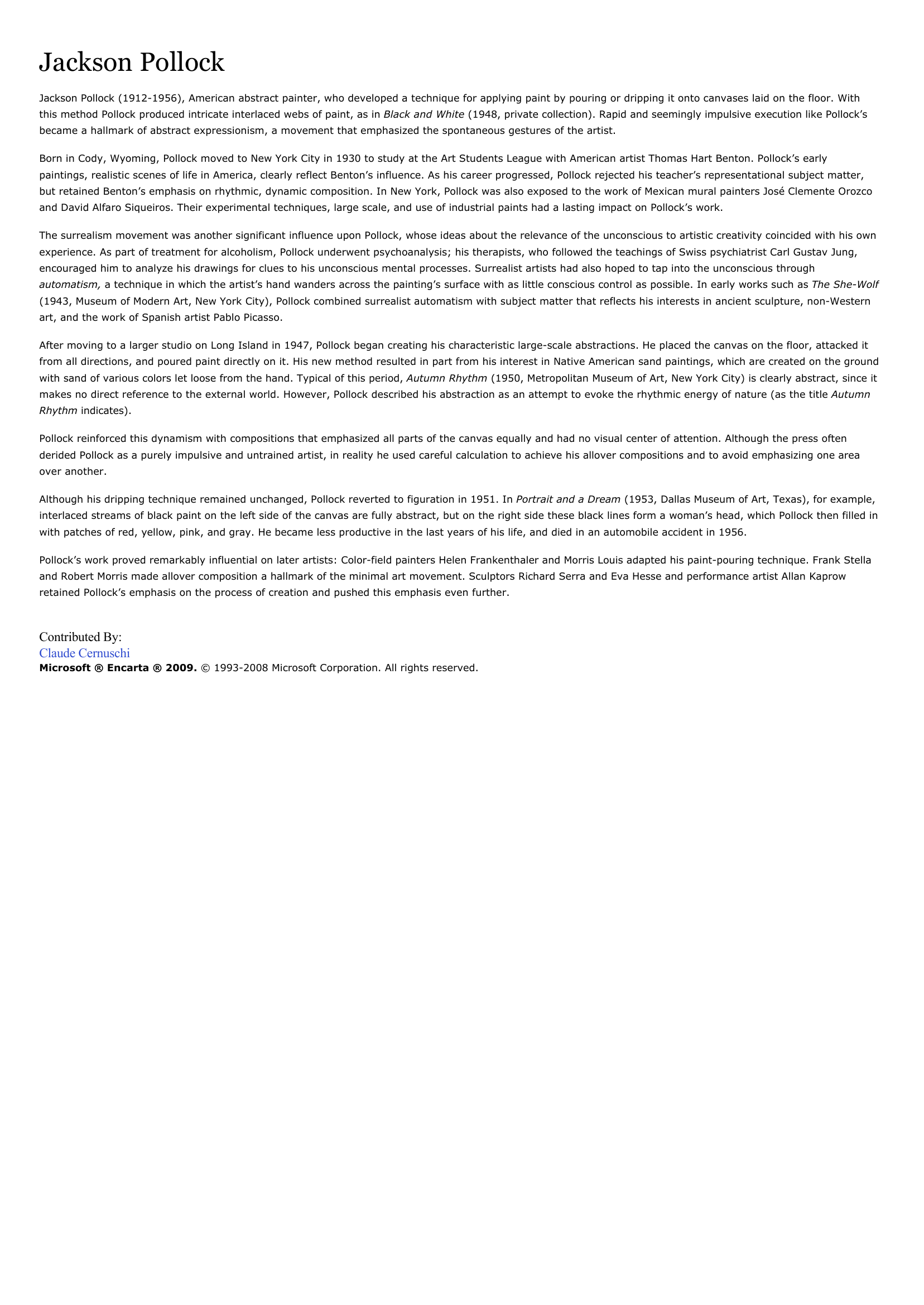Pollock Jackson
Publié le 05/04/2019

Extrait du document
Pollock Jackson Peintre américain
* 28.1.1912, Cody, Wyoming
+ 11.8.1956, Springs, Long Island
Après des débuts dans la tradition de la peinture réaliste, Pollock s'intéresse à l'art mural mexicain, à l'art abstrait de l'avant-garde européenne, et développe ses propres moyens d'expression. Par sa technique du \"dripping\" (de l'anglais \"to drip\", \"tomber goutte à goutte\") sur la toile posée au sol, il fonde l'\"action painting\", manière de peindre qui conjugue spontanéité de l'inspiration et planification précise des moyens mis en oeuvre. Après 1946, ses tableaux renoncent entièrement à tout élément figuratif ; la forme y importe moins que l'impulsion du geste pictural. Ils se caractérisent par des réseaux de lignes colorées, entremêlées, qui laissent entrevoir le fond de la toile (\"Lavender Mist n° 1\", \"Autumn Rythm\", \"One\", 1950). Grand maître américain de l'expressionnisme abstrait, Pollock ouvre des voies nouvelles à l'art de la seconde moitié du XXe siècle. Ses recherches sont brutalement interrompues par sa mort accidentelle.
«
Powered by TCPDF (www.tcpdf.org)Jackson Pollock
Jackson Pollock (1912-1956), American abstract painter, who developed a technique for applying paint by pouring or dripping it onto canvases laid on the floor.
With this method Pollock produced intricate interlaced webs of paint, as in Black and White (1948, private collection).
Rapid and seemingly impulsive execution like Pollock’s became a hallmark of abstract expressionism, a movement that emphasized the spontaneous gestures of the artist.
Born in Cody, Wyoming, Pollock moved to New York City in 1930 to study at the Art Students League with American artist Thomas Hart Benton.
Pollock’s earlypaintings, realistic scenes of life in America, clearly reflect Benton’s influence.
As his career progressed, Pollock rejected his teacher’s representational subject matter,but retained Benton’s emphasis on rhythmic, dynamic composition.
In New York, Pollock was also exposed to the work of Mexican mural painters José Clemente Orozcoand David Alfaro Siqueiros.
Their experimental techniques, large scale, and use of industrial paints had a lasting impact on Pollock’s work.
The surrealism movement was another significant influence upon Pollock, whose ideas about the relevance of the unconscious to artistic creativity coincided with his ownexperience.
As part of treatment for alcoholism, Pollock underwent psychoanalysis; his therapists, who followed the teachings of Swiss psychiatrist Carl Gustav Jung,encouraged him to analyze his drawings for clues to his unconscious mental processes.
Surrealist artists had also hoped to tap into the unconscious throughautomatism, a technique in which the artist’s hand wanders across the painting’s surface with as little conscious control as possible.
In early works such as The She-Wolf (1943, Museum of Modern Art, New York City), Pollock combined surrealist automatism with subject matter that reflects his interests in ancient sculpture, non-Westernart, and the work of Spanish artist Pablo Picasso.
After moving to a larger studio on Long Island in 1947, Pollock began creating his characteristic large-scale abstractions.
He placed the canvas on the floor, attacked itfrom all directions, and poured paint directly on it.
His new method resulted in part from his interest in Native American sand paintings, which are created on the groundwith sand of various colors let loose from the hand.
Typical of this period, Autumn Rhythm (1950, Metropolitan Museum of Art, New York City) is clearly abstract, since it makes no direct reference to the external world.
However, Pollock described his abstraction as an attempt to evoke the rhythmic energy of nature (as the title Autumn Rhythm indicates).
Pollock reinforced this dynamism with compositions that emphasized all parts of the canvas equally and had no visual center of attention.
Although the press oftenderided Pollock as a purely impulsive and untrained artist, in reality he used careful calculation to achieve his allover compositions and to avoid emphasizing one areaover another.
Although his dripping technique remained unchanged, Pollock reverted to figuration in 1951.
In Portrait and a Dream (1953, Dallas Museum of Art, Texas), for example, interlaced streams of black paint on the left side of the canvas are fully abstract, but on the right side these black lines form a woman’s head, which Pollock then filled inwith patches of red, yellow, pink, and gray.
He became less productive in the last years of his life, and died in an automobile accident in 1956.
Pollock’s work proved remarkably influential on later artists: Color-field painters Helen Frankenthaler and Morris Louis adapted his paint-pouring technique.
Frank Stellaand Robert Morris made allover composition a hallmark of the minimal art movement.
Sculptors Richard Serra and Eva Hesse and performance artist Allan Kaprowretained Pollock’s emphasis on the process of creation and pushed this emphasis even further.
Contributed By:Claude CernuschiMicrosoft ® Encarta ® 2009. © 1993-2008 Microsoft Corporation.
All rights reserved..
»
↓↓↓ APERÇU DU DOCUMENT ↓↓↓
Liens utiles
- Pollock Jackson Peintre américain
- Jackson Pollock 1912-1956 Convergence 1952 PL. XX Huile sur toile, 237, 4 x 396,2 cm Albright — Knox Art Gallery, Buffalo, Etat de New York
- One. Number 31 1950 Jackson Pollock (1912-1956)
- Pollock, Jackson - vie et oeuvre du peintre.
- Jackson Pollock, n°5

































